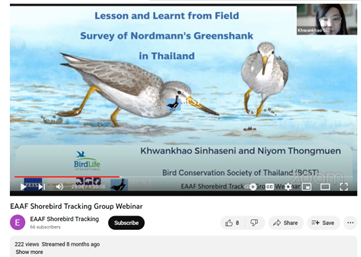EAAFP Small Grant Fund project by
Ying Chi Chan
University of Groningen
![]()
Banding shorebirds as a means of understanding their movements has been conducted in the EAAF for several decades. Nowadays, an increasing number of people all along the flyway contribute to this effort by reporting sightings of previously tagged birds (e.g., Lagassé et al. 2020). These contributions have resulted in a greater understanding of the distribution and timing of shorebird migrations. Recently, researchers have employed various technologies, such as satellite transmitters, geolocators, and GSM-based trackers, to map out the migratory routes of these birds. This has helped us gain insights into individual migration patterns and has filled in gaps in knowledge in areas where there are fewer bird-banding conducted and sightings of banded birds (e.g. Chan et al. 2019). The scientific information generated by these studies has been crucial in recognizing the importance of the Yellow Sea, leading to the designation of important areas as a new World Heritage Site (e.g. Piersma et al. 2017).
Although an increasing number of tracking studies have been conducted by various institutions/groups across the flyway, there is little coordination and lack of prioritization on species and populations to be tracked. Furthermore, the wide variety of techniques, their constant development, difficulties in analyzing data, and raising funds to purchase the tracking devices have created challenges for people hoping to begin using these techniques. Given the urgent need to conserve declining migratory shorebird populations across the EAAF, it is imperative to create a Shorebird Tracking Group that can provide a platform to share information and techniques, allow and promote collaborations across the nonbreeding range of a species and across multiple species using the same site, utilizing the full potential of tracking data in conservation of shorebirds in this flyway.
The need for this group was apparent during enthusiastic discussions by participants of the 1st EAAF Shorebird Science Meeting held in November 2020. The group is open to anyone interested in studying or learning about shorebird migration.
Here are the goals of the EAAF Shorebird Tracking Group (EAAF STG):
- establish group membership and tracking project directory to determine existing work occurring within the EAAF,
- coordinate/lead on-line meetings to facilitate exchange of ideas and techniques, promote collaborations between researchers, and between researchers and conservation organizations, and
- garner support to projects and initiatives that promote shorebird conservation in the EAAF using science-based tracking information.
Project Directory
A project directory of past and current shorebird telemetry studies occurring within the EAAF was established. For each project, principal investigators are asked to list the species, tag deployment location, tracking device, years of study, organisation, contact person and email, and a link to their project website (optional). This allows an overview of what has and has not occurred to date, helping to identify knowledge gaps and prioritize future collaborative projects. Please view the current project directory here: trackeaaf.org/projects
Webinar series
Regular online meetings in the form of seminars on the topic on migration and movement ecology or tracking techniques were organized by the EAAF STG.
 |
 |
Screenshots of EAAF Shorebird Tracking Group Webinar
Recordings of the most recent webinars are available on a youtube channel https://www.youtube.com/@trackeaaf
From April 2021 to November 2022, there were 11 webinars organized, on average every 1-2 months. There were 21 speakers, and 3 of them gave a talk two times. Some webinars were organized with a theme, such as the Bar-tailed godwit (12 July 2021) and Nordmann’s Greenshank (1 September 2022). Researchers studying populations of shorebirds in flyways other than the EAAF were occasionally invited. The purpose was to exchange information and stimulate potential collaborations.
For the list of past webinars, please check our website: trackeaaf.org/activities
If you are interested to receive news related to tracking shorebirds e.g. webinars related to shorebirds and/or bird-tracking organized by other organisations, conferences, and conservation activities, please request to join the mailing list at the website’s contact form: trackeaaf.org/contact
References
- Battley, P. F., Warnock, N., Tibbitts, T. L., Gill Jr, R. E., Piersma, T., Hassell, C. J., ... & Riegen, A. C. (2012). Contrasting extreme long‐distance migration patterns in bar‐tailed godwits Limosa lapponica. Journal of Avian Biology, 43(1), 21-32.
- Chan, Y. C., Tibbitts, T. L., Lok, T., Hassell, C. J., Peng, H. B., Ma, Z., ... & Piersma, T. (2019). Filling knowledge gaps in a threatened shorebird flyway through satellite tracking. Journal of Applied Ecology, 56(10), 2305-2315.
- Lagassé, B. J., Lanctot, R. B., Barter, M., Brown, S., Chiang, C. Y., Choi, C. Y., ... & Wunder, M. B. (2020). Dunlin subspecies exhibit regional segregation and high site fidelity along the East Asian–Australasian Flyway. The Condor, 122(4), duaa054.
- Piersma, T., Chan, Y. C., Mu, T., Hassell, C. J., Melville, D. S., Peng, H. B., ... & Wilcove, D. S. (2017). Loss of habitat leads to loss of birds: reflections on the Jiangsu, China, coastal development plans. Wader Study, 124(2), 93-98.
Join the EAAF Shorebird Tracking Group: https://forms.gle/CHbntPrMCGypGiZK6
East Asian-Australasian Flyway Shorebird Tracking Projects Directory: https://eaafprojects.netlify.app/
To include your project to the directory: https://form.jotform.com/210225083733043
Learn about EAAFP Shorebird Working Group: https://www.eaaflyway.net/shorebird-working-group/
The project was funded through the 2021 EAAFP WG/TF Small Grant Fund. View the report, Click here.




